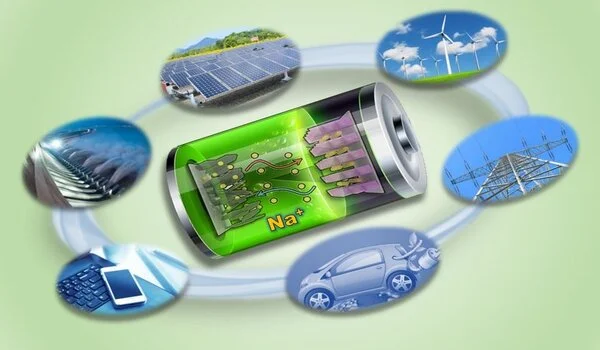The transition to a society without fossil fuels means that the demand for batteries is rapidly increasing. Simultaneously, the increase will result in a scarcity of the metals lithium and cobalt, which are essential components of the most common battery types. A sodium-ion battery is one option, with table salt and biomass from the forest industry serving as the primary raw materials. Researchers from Chalmers University of Technology in Sweden have now demonstrated that sodium-ion batteries have the same climate impact as lithium-ion batteries – without the risk of running out of raw materials.
“The materials we use in future batteries will be important in order to be able to switch to renewable energy and a fossil-free vehicle fleet,” says Rickard Arvidsson, Associate Professor of Environmental Systems Analysis at Chalmers.
According to the European Commission’s Critical Raw Materials Act, demand for critical raw battery materials is expected to rise exponentially as EU countries transition to renewable energy systems and electric vehicles. The green transition will also necessitate more local production of batteries and other new fossil-free technologies, as well as a steady supply of raw materials to meet demand. At the same time, due to the scarcity of raw material sources, such production is fraught with supply disruptions.
“Lithium-ion batteries are becoming a dominant technology in the world and they are better for the climate than fossil-based technology is, especially when it comes to transport. But lithium poses a bottleneck. You can’t produce lithium-based batteries at the same rate as you want to produce electric cars, and the deposits risk being depleted in the long term,” says Rickard Arvidsson. In addition to this, critical battery materials, such as lithium and cobalt, are largely mined in just a few places in the world, posing a risk to the supply.
Lithium-ion batteries are becoming a dominant technology in the world and they are better for the climate than fossil-based technology is, especially when it comes to transport. But lithium poses a bottleneck. You can’t produce lithium-based batteries at the same rate as you want to produce electric cars, and the deposits risk being depleted in the long term.
Rickard Arvidsson
Sodium-ion batteries offer promising technology
The development of new battery technologies is accelerating in the pursuit of the next generation of sustainable energy storage, which should ideally have a long lifetime, a high energy density, and be simple to manufacture. The Chalmers team chose to investigate sodium-ion batteries, which contain sodium – a common substance found in common sodium chloride – rather than lithium. They conducted a so-called life cycle assessment of the batteries in a new study, in which they examined their total environmental and resource impact during raw material extraction and manufacturing.
“We came to the conclusion that sodium-ion batteries are much better than lithium-ion batteries in terms of impact on mineral resource scarcity, and equivalent in terms of climate impact. Depending on which scenario you look at, they end up at between 60 and just over 100 kilogrammes of carbon dioxide equivalents per kilowatt hour theoretical electricity storage capacity, which is lower than previously reported for this type of sodium-ion battery. It’s clearly a promising technology,” says Rickard Arvidsson.
The researchers also identified a number of measures with the potential to further reduce climate impact, such as developing an environmentally better electrolyte, as it accounted for a large part of the battery’s total impact.

Green energy requires energy storage
Today’s sodium-ion batteries are already expected to be used for stationary energy storage in the electricity grid, and with continued development, they will probably also be used in electric vehicles in the future. “Energy storage is a prerequisite for the expansion of wind and solar power. Given that the storage is done predominantly with batteries, the question is what those batteries will be made from? Increased demand for lithium and cobalt could be an obstacle to this development,” says Rickard Arvidsson.
The primary benefit of the technology is that the materials used in sodium-ion batteries are plentiful and can be found all over the world. One electrode in the batteries, the cathode, uses sodium ions as a charge carrier, and the other electrode, the anode, is made of hard carbon, which can be produced from biomass from the forest industry in one of the examples studied by the Chalmers researchers. In terms of manufacturing processes and geopolitics, sodium-ion batteries are another option that can hasten the transition to a fossil-free society. “Batteries based on abundant raw materials could reduce geopolitical risks and dependencies on specific regions, both for battery manufacturers and countries,” Arvidsson said.
More about the study
The study is a prospective life cycle assessment of two different sodium-ion battery cells where the environmental and resource impact is calculated from cradle to gate, i.e. from raw material extraction to the manufacture of a battery cell. The functional unit of the study is 1 kWh theoretical electricity storage capacity at the cell level. Both types of battery cells are mainly based on abundant raw materials.
The anode is made of hard carbon derived from either bio-based lignin or fossil raw materials, while the cathode is made of “Prussian white” (which contains sodium, iron, carbon, and nitrogen). A sodium salt is present in the electrolyte. The production is designed to simulate large-scale production in the future. For example, actual battery cell production is based on today’s large-scale production of lithium-ion batteries in gigafactories.
Two different electricity mixes were tested, as were two different types of so-called allocation methods – that is, resource and emission allocation. One method distributes the climate and resource impact among coproducts based on mass, and another allocates all impact to the main product (sodium-ion battery and its components).





